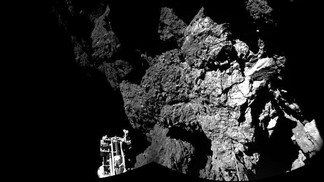Nov 14 2014
The small robot Philae left its mothership Rosetta and landed on the back of the comet Chury, 500 million kilometers away from Earth. Although there are still uncertainties about its anchorage, the achievement is a major leap forward for science. Grégoire Bourban, space engineer and Deputy Director of the EPFL Swiss Space Center, shares his expert viewpoint on the event.
 © ESA/Rosetta/Philae/CIVA
© ESA/Rosetta/Philae/CIVA
At 5:01 pm Wednesday evening, the Philae lander touched down on the surface of comet 67P/Churyumov-Gerasimenko – Chury, for short – seven hours after taking leave of its mothership, the Rosetta orbiter. Although there are still concerns about its anchoring and the resulting feasibility of some operations, the washing-machine sized robot has already gotten to work, sending data and spectacular images of its new surroundings.
Launched in 2004 by the European Space Agency, the probe made a 10-year voyage, traveling 500 million kilometers from Earth, to wind up somewhere between the orbits of Mars and Jupiter. In March, Rosetta’s systems were rebooted successfully as it approached the comet, and in August it began to orbit. The first photos of the comet revealed a fascinating shape, seemingly the result of an agglomeration of two rocky cores. The images sent yesterday by Philae indicate that the comet seems to be made up primarily of rock, and not ice. Grégoire Bourban space engineer and Deputy Director of the EPFL Swiss Space Center, gives us his engineer’s viewpoint on this exceptional event.
Why was this operation such a huge challenge, from a space engineering point of view?
In the heat of the operation, Wednesday, someone dared to compare this adventure with the first human moon landing. And I share that opinion. Because this operation is very different from others that have involved a lander. For the missions on Venus or Mars, for example, we were dealing with bodies that had been studied for a long time, and we understood the precise nature of the ground we’d be landing on. In addition, they were much larger targets, with many appropriate landing spots. What is unique about Chury is that we knew next to nothing about it in August 2014; but we had to choose a landing site, then make millions of descent calculations, studying various trajectories. Managing to do this successfully, from 500 million miles away, is quite simply incredible!
What will Philae allow us to study, and how will it operate?
The Philae mission is a true success, even if the lander has experienced some anchoring issues and only two of its three feet appear to be stable. We still don’t know what the consequences of this will be on the analysis operations. If all goes as planned, the lander and orbiter will remain for an entire year in this configuration, accompanying a comet for the first time ever in its trip around the Sun. As it approaches the sun, its core will begin to melt, and thus it will release gases that will react with others already in suspension. Comets are considered to be a possible origin of the presence of water on Earth, and studying this comet’s composition could thus give us valuable information about our origins.
To carry out these tasks, Philae is equipped with various instruments for analyzing particles, electromagnetic radiation, various gases, soil properties and even the sounds that the comet emits. It can bore up to 20 centimeters beneath the surface and remove samples. It’s these soil-sampling operations that are in question due to the failure of the harpoons to anchor the lander. And given the weak gravity, even a very small perturbation could eject the robot from the surface.
Some elements or instruments on board Philae and Rosetta were made in Switzerland. Which ones are they and what do they do?
There was a significant Swiss involvement in this project. The most well known instrument is Rosina; developed at the University of Bern, it’s what we call a mass spectrometer. Its objective is to analyze the composition of the comet’s atmosphere, the temperature and density of the gases, and their evolution as the comet approaches the Sun. Several companies, including APCO and Clemessy, also developed ground-based support systems, that is, everything used to test the electrical and mechanical properties of the instruments before they’re launched into space. Certain components, most notably the mechanisms for pointing the communications antenna and the solar panel supports, were built by Mecanex in Nyon, which is now part of the company RUAG Space. Finally, some of Philae’s micro-cameras were developed at the CSEM in Neuchâtel. The first images sent from the surface of the comet, made public yesterday morning, came from these instruments!
What lessons can we learn from this for future space operations and exploration?
Missions like this are very rare, because they are terribly costly in terms of both money and time – more than €1.5 billion and 20 years of work went into Rosetta. The concrete results that she will provide and the public enthusiasm we’re seeing are extremely positive signals for us, because they will encourage decision makers in European countries to continue to invest in space projects and fund the ESA. One of the most significant interests of this mission, in engineering terms, is in robotics and automation. In the space sector, we’re usually dealing with telecoms satellites or observational satellites orbiting Earth, and thus primarily sensor technology. Rosetta is a spectacular demonstration that these technologies [robotics and automation, ed.] operate well in space, and could thus encourage an increase in launching more robotics-type projects.